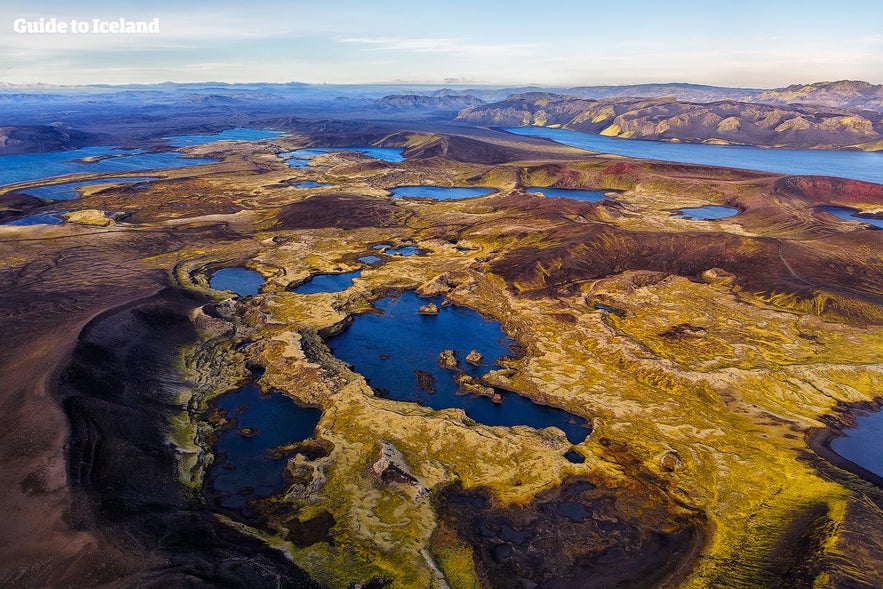The Icelandic Highlands cover the majority of the country and many of Iceland’s impressive natural attractions can be found here. Away from crowds, noise and bustle, the Highlands offer silence, serenity, peace and extreme natural beauty.
Visit the area on a tour of the Highlands of Iceland. A favourite amongst hikers and photographers, the Highlands are accessible from June to September.
Waarom u onze inhoud kunt vertrouwen
Guide to Iceland is het meest vertrouwde reisplatform in IJsland en helpt ieder jaar miljoenen bezoekers. Al onze content wordt geschreven en gecontroleerd door lokale experts die IJsland door en door kennen. U kunt op ons rekenen voor nauwkeurig, actueel en betrouwbaar reisadvies.
The Central Highlands
The Central Highlands cover a vast area, at an altitude of over 500 metres (1640 feet), with numerous mountains reaching heights between 1,000 and 2,000 metres (3,281 and 6562 feet). Most of these higher mountains are covered by glaciers.
The tallest mountain in the country is located in the Highlands, beneath Europe’s largest glacier, Vatnajökull. Hvannadalshnúkur stands at an incredible 2,109 metres (6,919 feet) tall and can be reached on some helicopter tours. Another notable peak is Bárðarbunga, a sub-glacial volcano in northwest Vatnajökull that stands at 2,000 metres.
Vatnajökull is the greatest of the three largest glaciers in the country, all of which are in the Central Highlands; the others are Hofsjökull in the centre of Iceland and Langjökull, west of Hofsjökull.
Various highlands paths lie between the glaciers. These usually open in June, but late snows have been known to push the opening to July. One of the major routes is Kjölur, which connects the south and north of Iceland. It is located between Hofsjökull and Langjökull and passes through a region of rhyolite mountains and geothermal oases.
Sprengisandur, is another noteworthy path connecting the south and north, and it is located between Hofsjökull and Vatnajökull.
Kaldidalur is also a significant highland road stretching west of Langjökull, from Þingvellir towards the Borgarfjörður district.
Always remember that the natural environment that makes up Iceland's Highlands is as delicate as it is enchanting. The slightest damage inflicted upon small areas can cause erosion and irreversible landscape wounds that can easily spread over large areas. Consequently, when travelling in the Highlands visitors must at all times uphold responsible travel etiquette.
Driving off-road and designated paths is strictly forbidden and punishable by heavy fines. The moss is delicate and should not be walked or camped on, let alone removed, and fishing is heavily regulated.
The South Highlands
Almost all the mountains south of the glaciers are tuff mountains, formed during the Ice Age. Volcanic activity is confined to tuff areas of the country and the southern Highlands are home to some of Iceland's most active volcanoes: Hekla, Eyjafjallajökull and Katla, which sits under Mýrdalsjökull, Iceland’s fourth largest glacier.
Eyjafjallajökull is the most famous of these volcanoes. When it erupted in 2010, it caused major disruption to air travel across Europe, and widespread confusion to newsreaders everywhere as they tried to pronounce it; it was thus nicknamed to E11.
The South Highlands is also home to Landmannalaugar, one of the country's best hiking and hot spring bathing sites.
Northeast, Central-North and Northwest Highlands
In the northeast of the Highlands are the Lakagígar Craters the famous subglacial lake and volcano, Grímsvötn, and the glacier Öræfajökull. North of Vatnajökull, the best-known volcanoes are Askja and Krafla.
Also in this area is the Jökulsárgljúfur canyon, which holds the most powerful waterfall in Europe, Dettifoss.
The northwest and central-north Highlands consist of ancient basalt formations, similar to the mountains that comprise the Eastfjords.
Highland Oases
There are a few oases in the highlands that have unique vegetation and wildlife. The most important of these are Þjórsárver, Nýidalur/Jökuldalur, Herðubreiðarlindir and Eyjabakkar. The pink-footed goose has its main nesting places at Þjórsárver and Eyjabakkar. Þjórsárver was designated as a Ramsar site in 1990.
Wild reindeer reside in the east Highlands; this is the only place they can be seen. Initially brought over for farming, the industry never took out and they have roamed free in their herds since.











